Corsair Neutron GTX SSD Review (240GB): Link A Media Controller Tested
by Anand Lal Shimpi on August 20, 2012 6:00 AM EST- Posted in
- Storage
- SSDs
- Corsair
- Neutron
- Link a Media
AnandTech Storage Bench 2011
Two years ago we introduced our AnandTech Storage Bench, a suite of benchmarks that took traces of real OS/application usage and played them back in a repeatable manner. I assembled the traces myself out of frustration with the majority of what we have today in terms of SSD benchmarks.
Although the AnandTech Storage Bench tests did a good job of characterizing SSD performance, they weren't stressful enough. All of the tests performed less than 10GB of reads/writes and typically involved only 4GB of writes specifically. That's not even enough exceed the spare area on most SSDs. Most canned SSD benchmarks don't even come close to writing a single gigabyte of data, but that doesn't mean that simply writing 4GB is acceptable.
Originally I kept the benchmarks short enough that they wouldn't be a burden to run (~30 minutes) but long enough that they were representative of what a power user might do with their system.
Not too long ago I tweeted that I had created what I referred to as the Mother of All SSD Benchmarks (MOASB). Rather than only writing 4GB of data to the drive, this benchmark writes 106.32GB. It's the load you'd put on a drive after nearly two weeks of constant usage. And it takes a *long* time to run.
1) The MOASB, officially called AnandTech Storage Bench 2011 - Heavy Workload, mainly focuses on the times when your I/O activity is the highest. There is a lot of downloading and application installing that happens during the course of this test. My thinking was that it's during application installs, file copies, downloading and multitasking with all of this that you can really notice performance differences between drives.
2) I tried to cover as many bases as possible with the software I incorporated into this test. There's a lot of photo editing in Photoshop, HTML editing in Dreamweaver, web browsing, game playing/level loading (Starcraft II & WoW are both a part of the test) as well as general use stuff (application installing, virus scanning). I included a large amount of email downloading, document creation and editing as well. To top it all off I even use Visual Studio 2008 to build Chromium during the test.
The test has 2,168,893 read operations and 1,783,447 write operations. The IO breakdown is as follows:
| AnandTech Storage Bench 2011 - Heavy Workload IO Breakdown | ||||
| IO Size | % of Total | |||
| 4KB | 28% | |||
| 16KB | 10% | |||
| 32KB | 10% | |||
| 64KB | 4% | |||
Only 42% of all operations are sequential, the rest range from pseudo to fully random (with most falling in the pseudo-random category). Average queue depth is 4.625 IOs, with 59% of operations taking place in an IO queue of 1.
Many of you have asked for a better way to really characterize performance. Simply looking at IOPS doesn't really say much. As a result I'm going to be presenting Storage Bench 2011 data in a slightly different way. We'll have performance represented as Average MB/s, with higher numbers being better. At the same time I'll be reporting how long the SSD was busy while running this test. These disk busy graphs will show you exactly how much time was shaved off by using a faster drive vs. a slower one during the course of this test. Finally, I will also break out performance into reads, writes and combined. The reason I do this is to help balance out the fact that this test is unusually write intensive, which can often hide the benefits of a drive with good read performance.
There's also a new light workload for 2011. This is a far more reasonable, typical every day use case benchmark. Lots of web browsing, photo editing (but with a greater focus on photo consumption), video playback as well as some application installs and gaming. This test isn't nearly as write intensive as the MOASB but it's still multiple times more write intensive than what we were running in 2010.
As always I don't believe that these two benchmarks alone are enough to characterize the performance of a drive, but hopefully along with the rest of our tests they will help provide a better idea.
The testbed for Storage Bench 2011 has changed as well. We're now using a Sandy Bridge platform with full 6Gbps support for these tests.
AnandTech Storage Bench 2011 - Heavy Workload
We'll start out by looking at average data rate throughout our new heavy workload test:
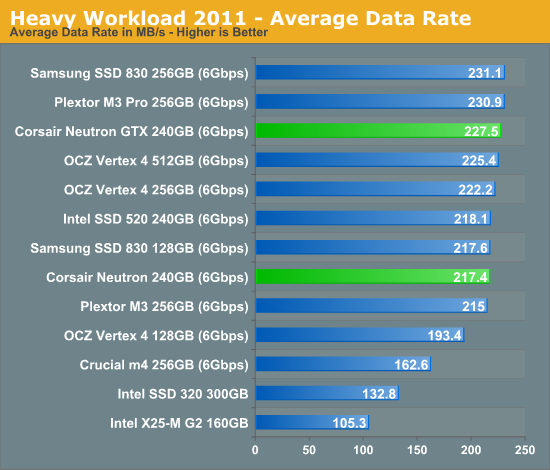
Without a doubt, Corsair's Neutron GTX is among the fastest drives we've tested here. In our most stressful use case, the Neutron GTX doesn't even break a sweat. The standard Neutron isn't too far behind either, the GTX outpaces it by just under 5%.
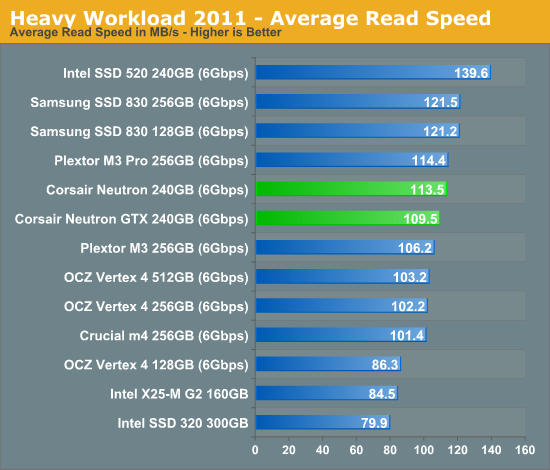
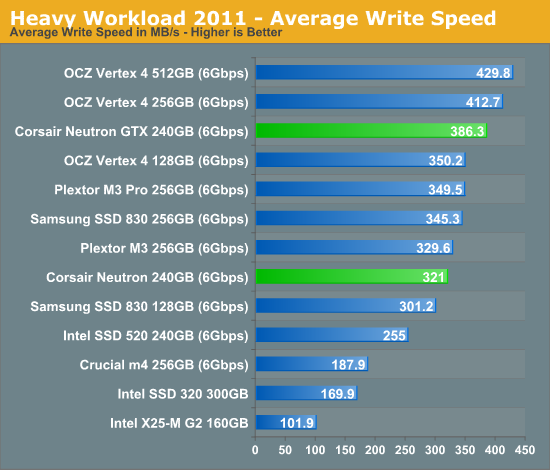
The next three charts just represent the same data, but in a different manner. Instead of looking at average data rate, we're looking at how long the disk was busy for during this entire test. Note that disk busy time excludes any and all idles, this is just how long the SSD was busy doing something:
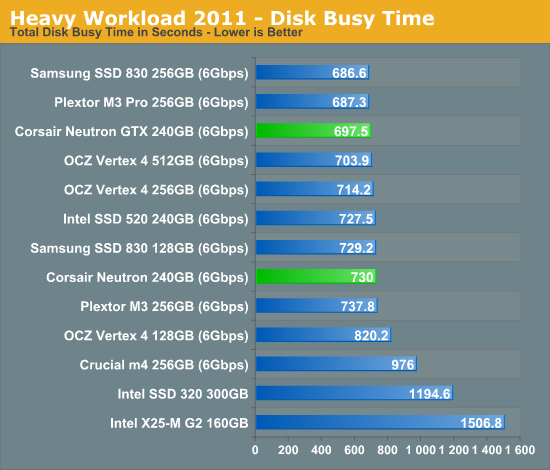
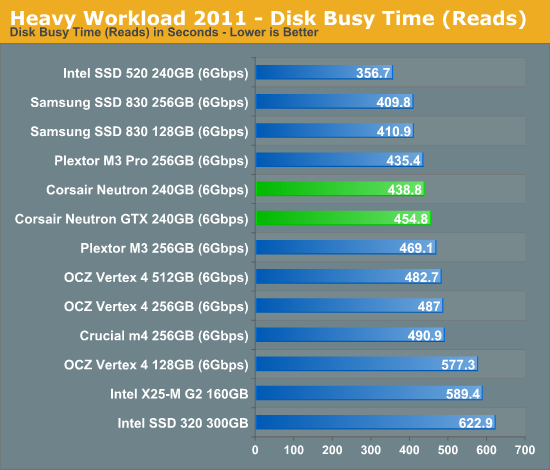
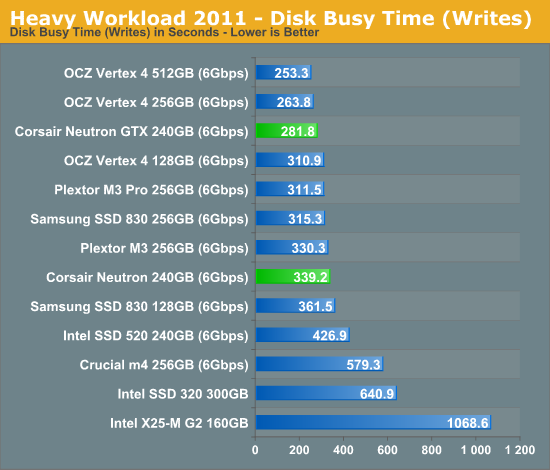










36 Comments
View All Comments
name99 - Tuesday, August 21, 2012 - link
"Load power consumption is much more competitive. It's not what I would consider low, but it's not unreasonably high either."Well I guess we all have different opinions...
IMHO the only number that matters is whether the maximum power draw (usually sequential writes) is below 2.5W. Below 2.5W and you know you can use it safely in a USB2 enclosure. Above that and it will appear to work but fail at random times.
You might think you only want to use this drive INSIDE a laptop. OK, if you are SURE of that. My experience is that drives move with time from one location to another, and it sucks if I have to throw them away when they're still good.
You might think you will only want to use this drive in a USB 3 enclosure (and now you have 4.5W to play with). OK.... but again life's going to suck if for some reason you want to use that drive on a USB2 machine.
IMHO SSD architects are behaving like Pentium4 architects, doing what they like while ignoring power issues. This is a path that does not end well. We'll already at the point where nobody gives a fsck about the difference between a streaming rate of 300MB/s and 330 MB/s --- but people DO care about battery life, and they do care about devices that are gratuitously heating up their rooms and warming their palms.
At some point point, these architects need to grow up and follow Intel down the path of speed at reasonable power, not speed at any power whatsoever.
KAlmquist - Monday, August 27, 2012 - link
Yes, it is disappointed to see SSD designs get worse over time in terms of power consumption. The Samsung 830 does a good job of holding down power usage when idle, but can draw more than the 4.5W limit of USB 3.0 when busy.dishayu - Wednesday, August 22, 2012 - link
Can we have the Plextor M5 Pro review please? I can't make up my mind if i should just pick up a Samsung 830 or wait for M5 Pro.Mr Perfect - Wednesday, August 22, 2012 - link
I know this sounds archaic, but could you throw a mechanical laptop drive into the power charts? At this point in time I honestly have no idea if these SSDs even have a power advantage over a modern spinner. It's hard to tell if a "bad" SSD is still better then a good mechanical, battery wise.Visual - Monday, August 27, 2012 - link
Unfortunately I do not have any media that I can link. ;)killabee_me - Wednesday, September 19, 2012 - link
Hi Anand,The test results didn't make it into Anandtech SSD Bench for some reason.
Could you make sure they get there?
Thanks.